Abstract
Bretylium depresses the slope of regression lines relating frequency of sympathetic nerve stimulation to magnitude of contractions of the cat nictitating membrane. In contrast, guanethidine and reserpine preferentially abolish responses to low rates of nerve stimulation and cause a roughly parallel shift of the regression lines. The hypersensitivity of the nictitating membranes of cats to intravenous adrenaline or noradrenaline is far greater after a series of small daily doses of bretylium or guanethidine than after single large doses. The maximal sensitivity produced was similar to that after postganglionic sympathetic nerve section and exceeded that produced by ganglion blockade. The development of hypersensitivity to catechol amines is accompanied by some return of responses of the nictitating membranes to sympathetic nerve stimulation despite continued daily administration of bretylium or guanethidine. In cats given bretylium daily, responses to low rates of nerve stimulation become greater than in controls unless the dose of bretylium given subcutaneously is 50 mg/kg or more. When marked hypersensitivity to catechol amines has been produced by giving bretylium or guanethidine daily for 7 or 14 days, the sympathomimetic effects of these compounds are greater. Responses to intravenous dimethylphenylpiperazinium are also increased and the results suggest that even large daily doses of adrenergic neurone blocking agents do not appreciably impair the functioning of the adrenal medulla. The pressor effects of intravenous adrenaline, noradrenaline and dimethylphenylpiperazinium iodide increase less than the corresponding nictitating membrane responses. These results are discussed in relation to tolerance to adrenergic neurone blockade, and differences between the effects of bretylium and guanethidine found in man. Bretylium and guanethidine depress the slopes of the dose-response curves for the pressor and nictitating membrane contracting effects of tyramine. When single doses or a short series of daily doses were given, guanethidine caused more depression of the slopes than did bretylium, but nevertheless large depressions of slope were found after giving bretylium daily for several weeks. The magnitude of the responses can be greater or less than in controls depending on the dose of the sympathomimetic amine, the dose of the adrenergic neurone blocking agent and the duration of its administration. The results suggest that injection of tyramine produces a progressively smaller release of adrenaline or noradrenaline during the daily administration of bretylium (or guanethidine) but that in some test situations this is more than compensated for by the development of hypersensitivity to the catechol amine released. Some corresponding changes in responses to amphetamine and ephedrine are also described.
Full text
PDF
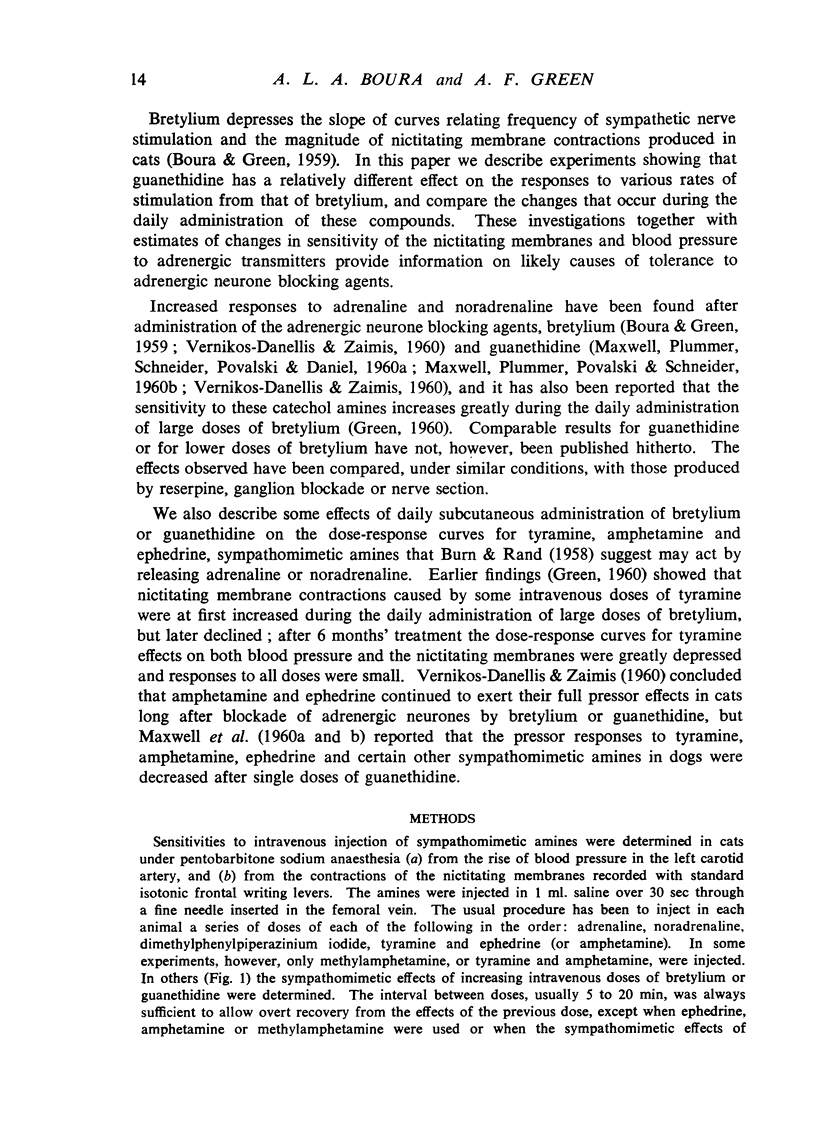
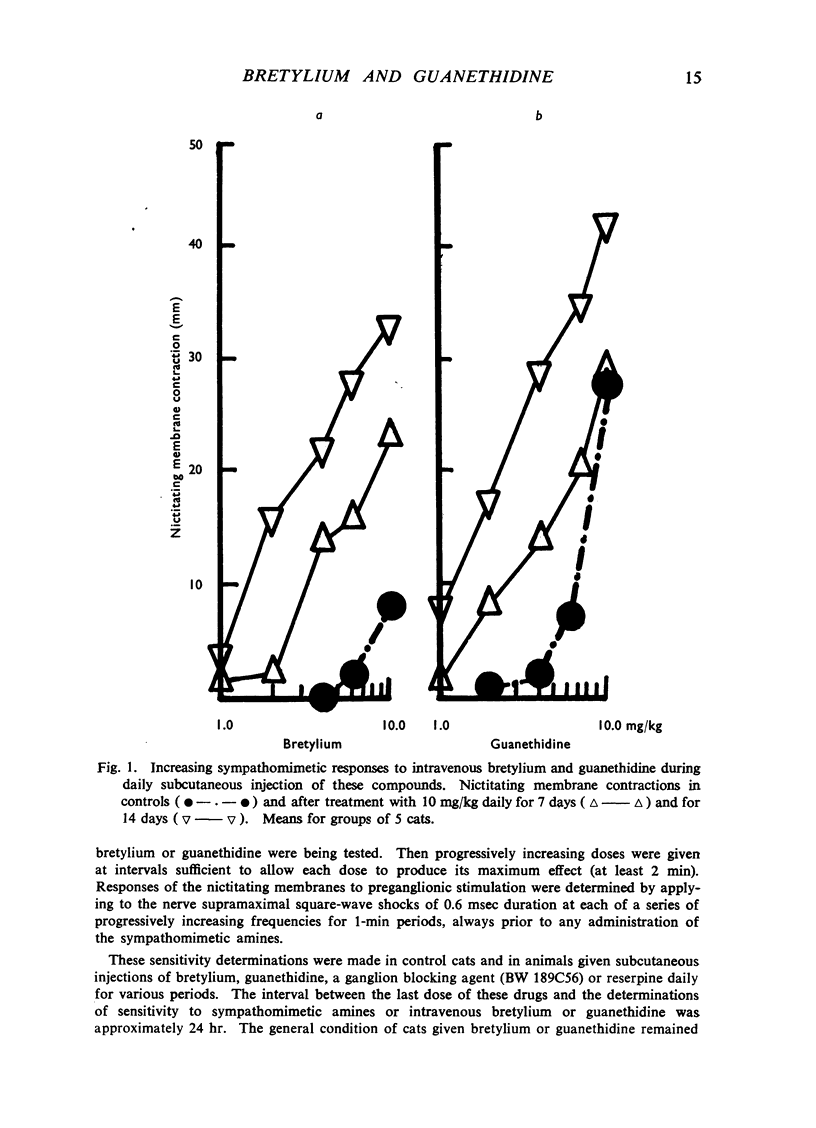
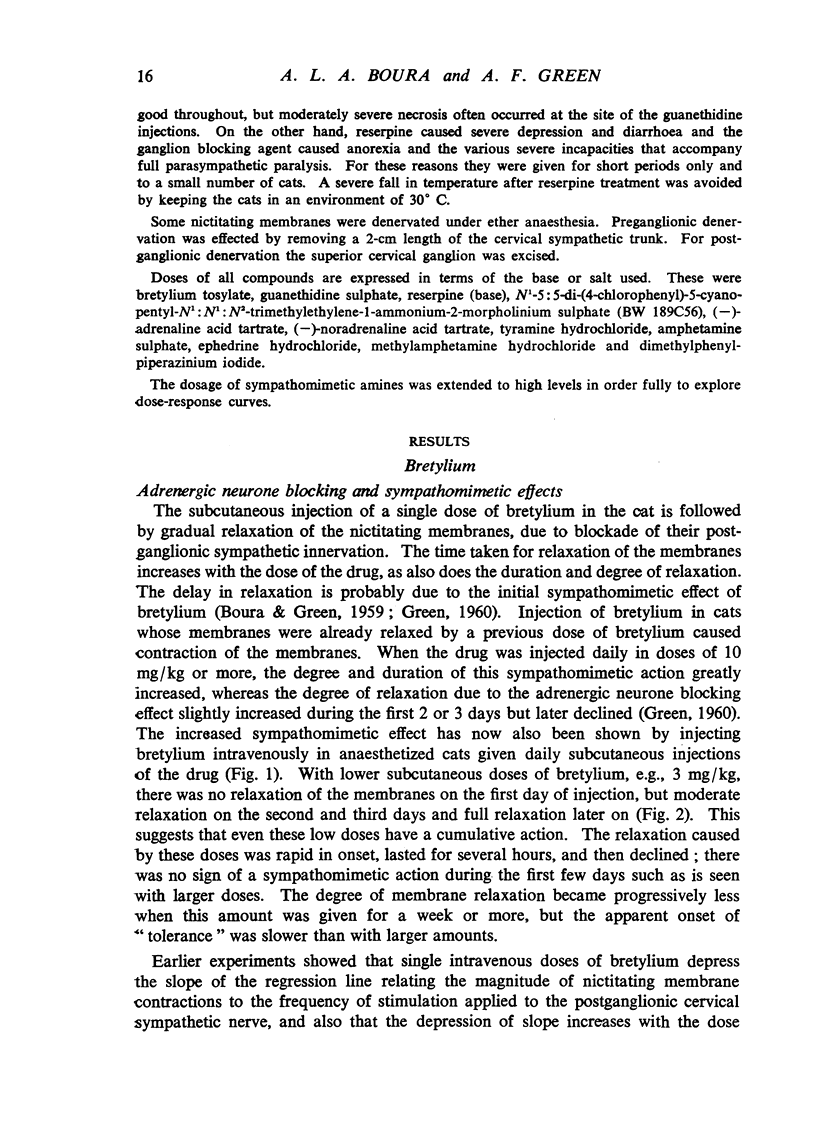
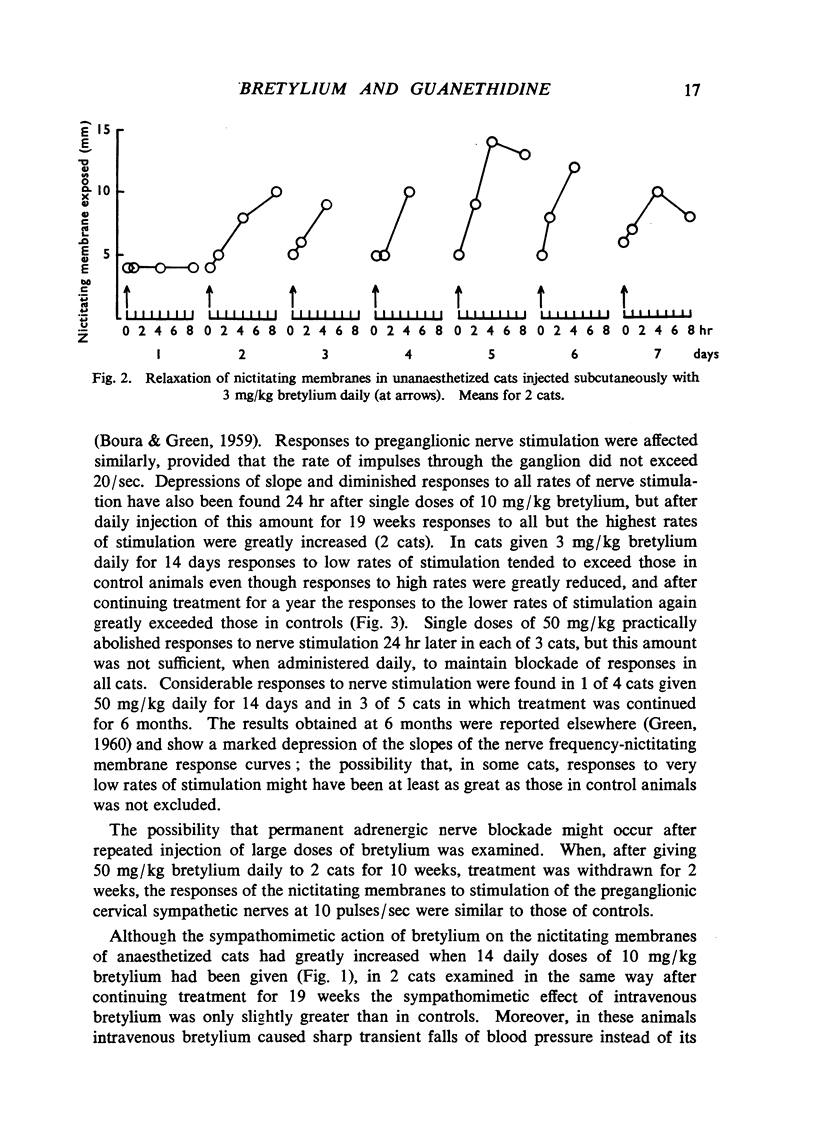
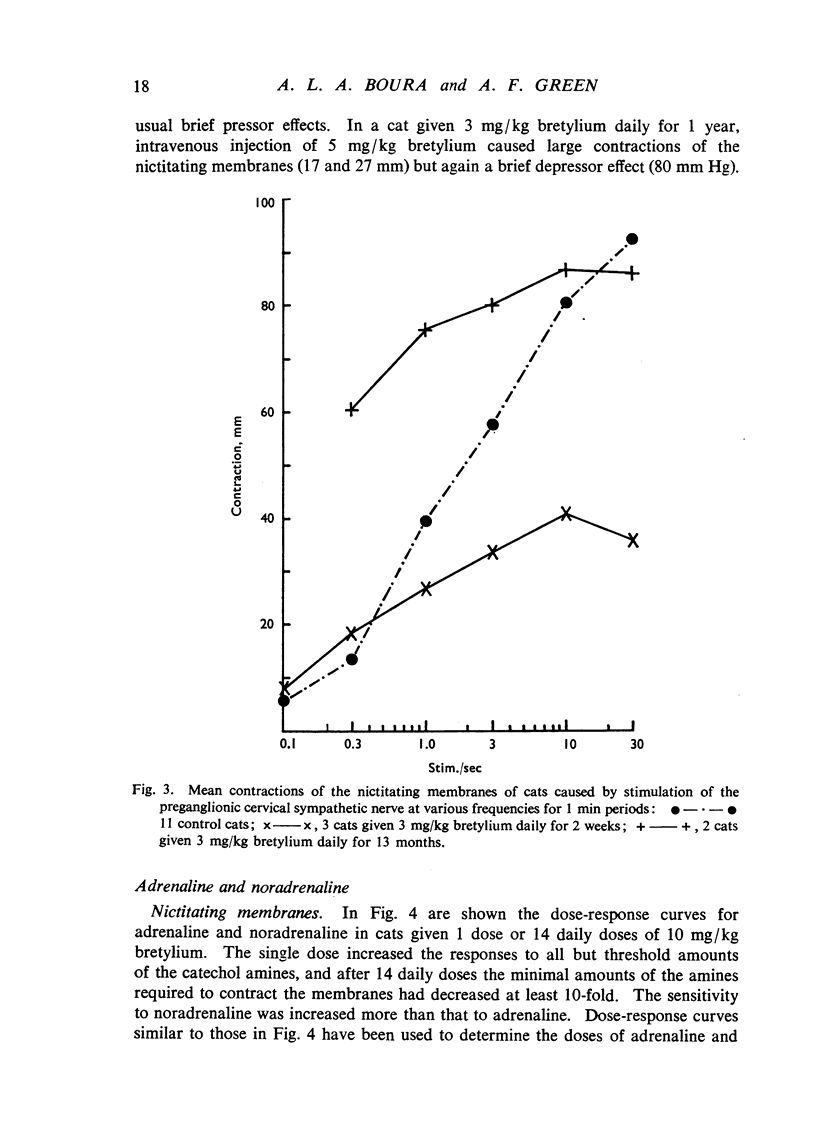
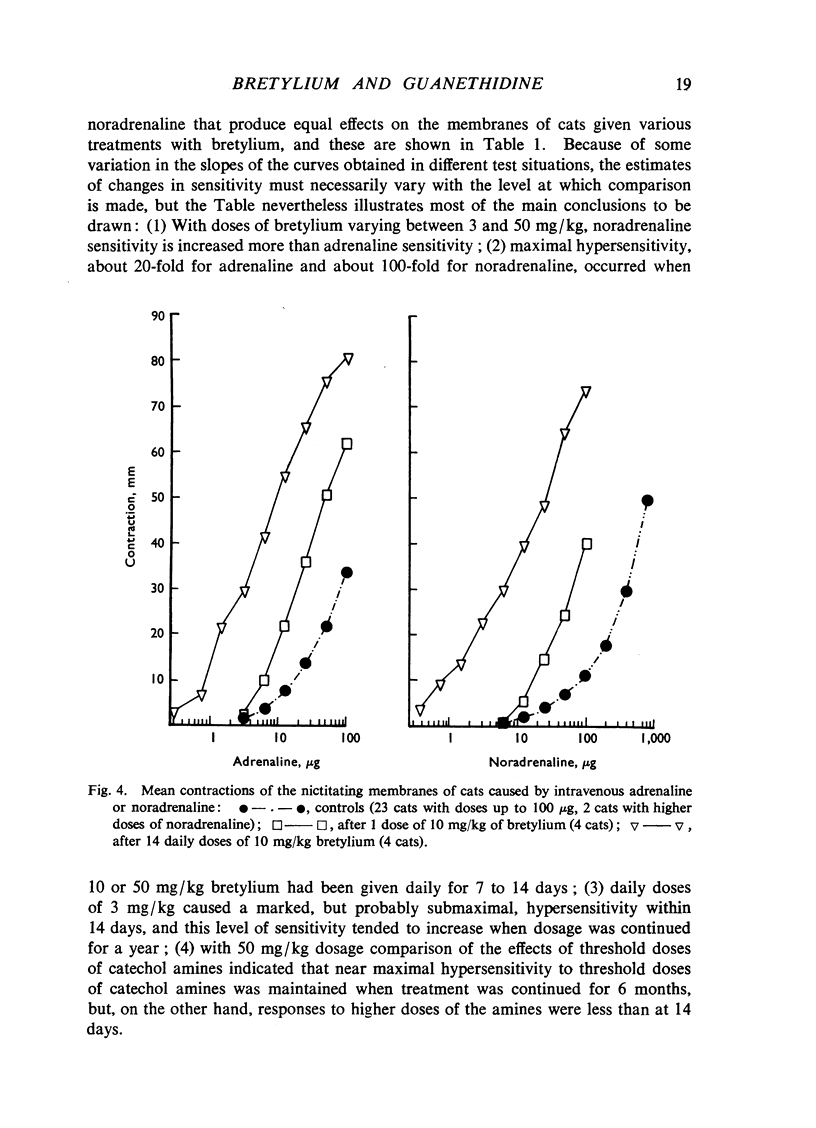
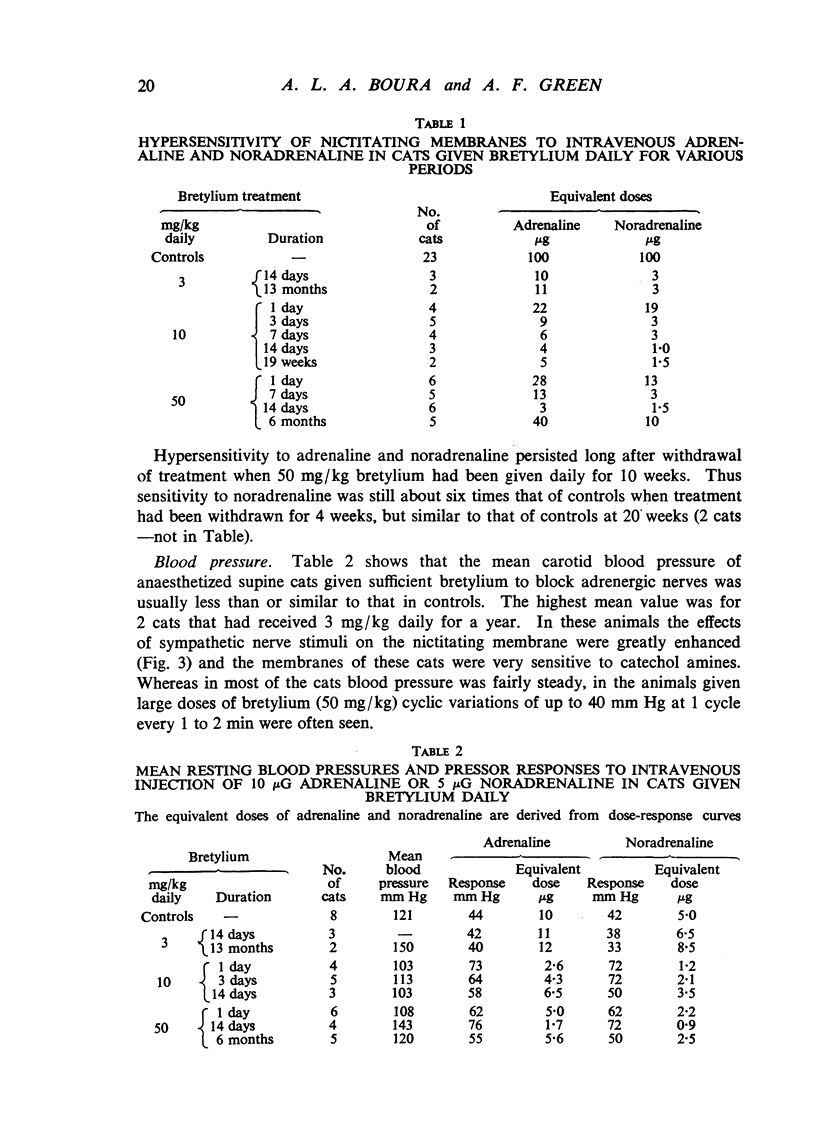
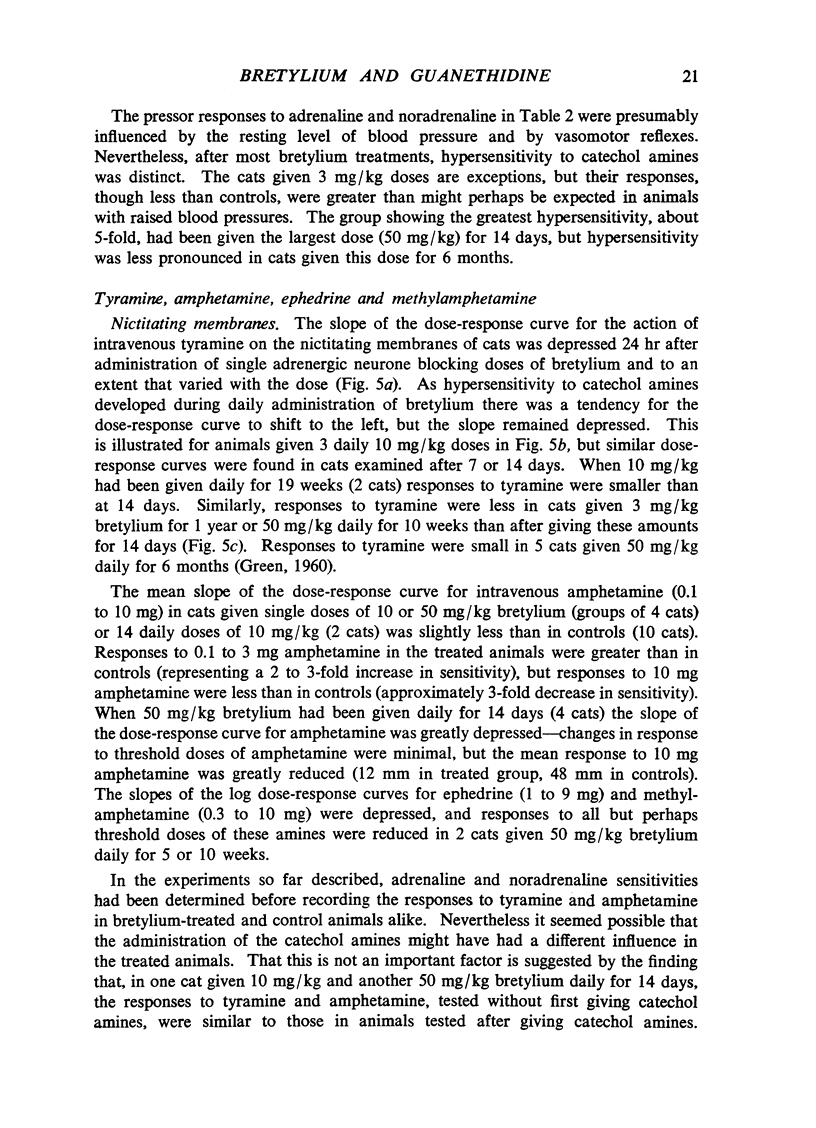
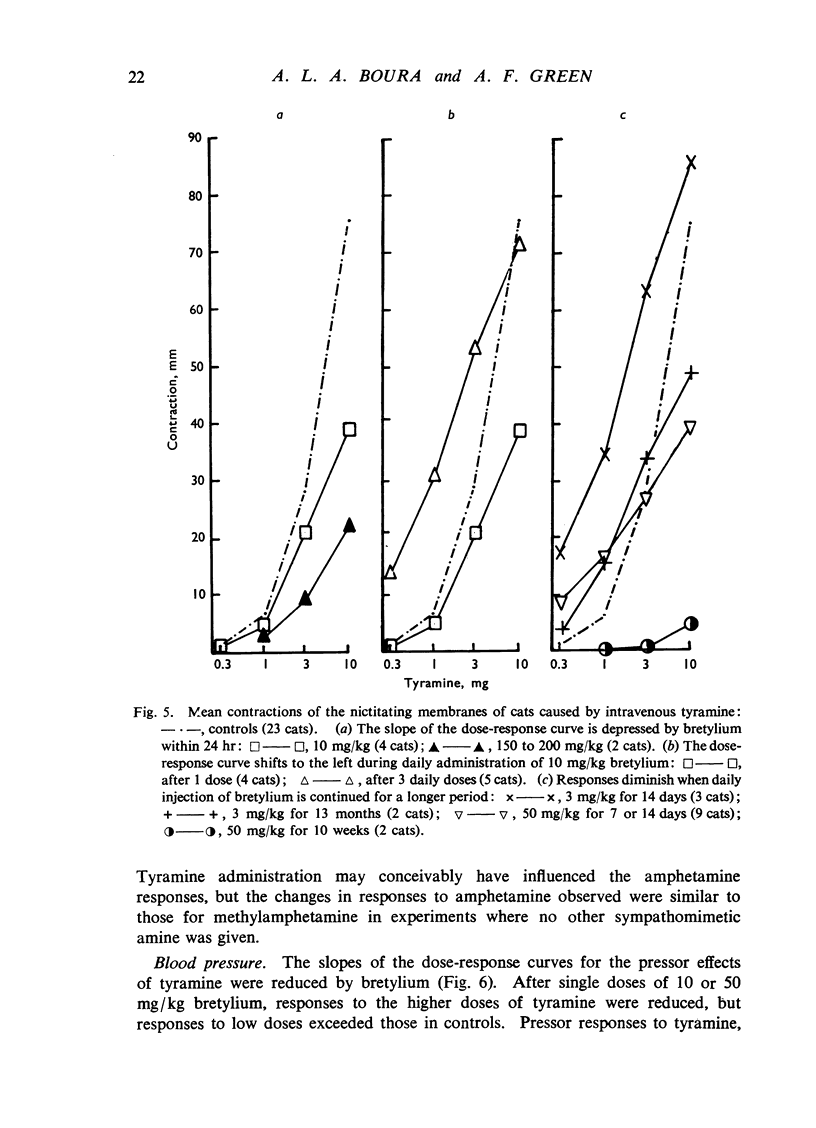
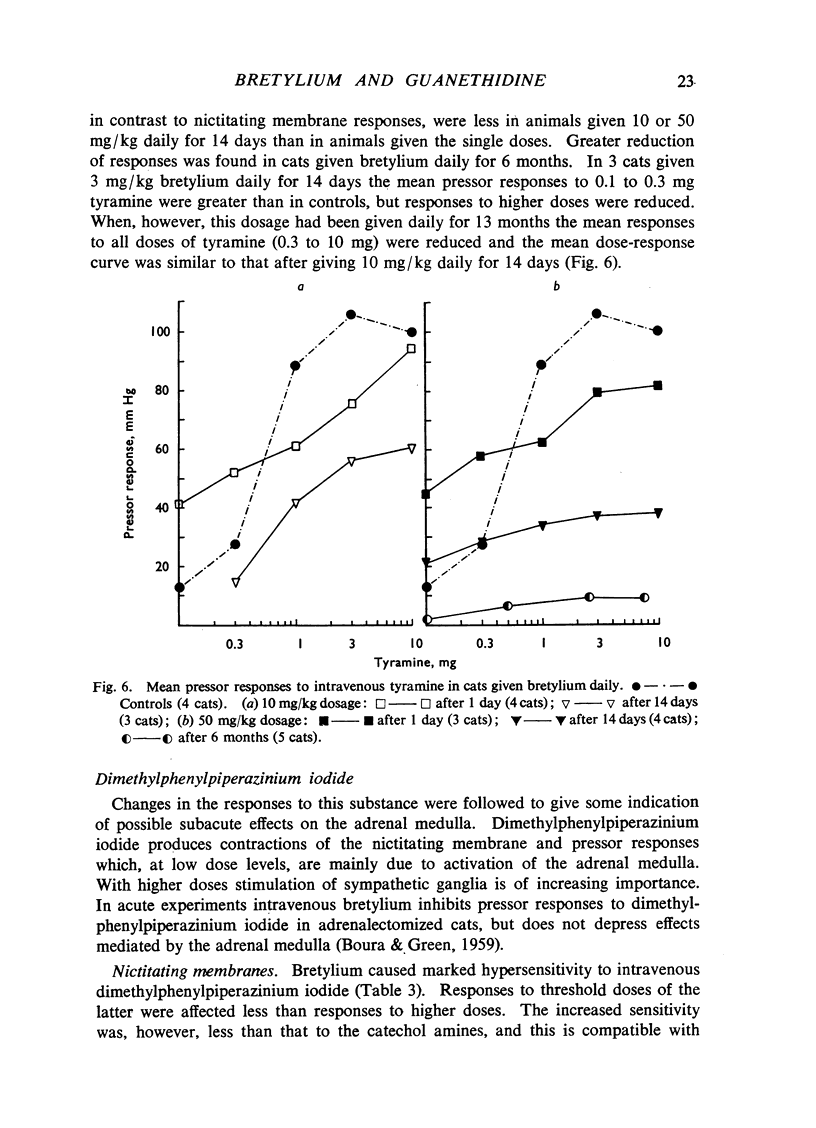
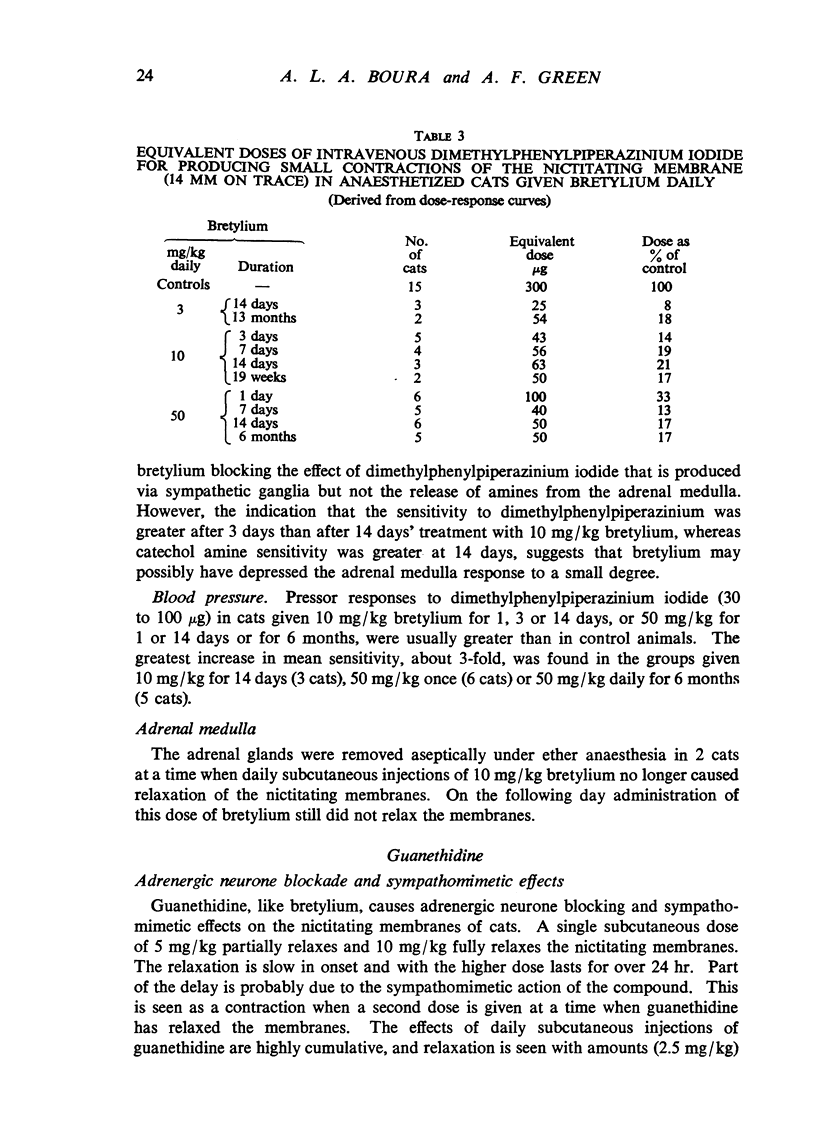
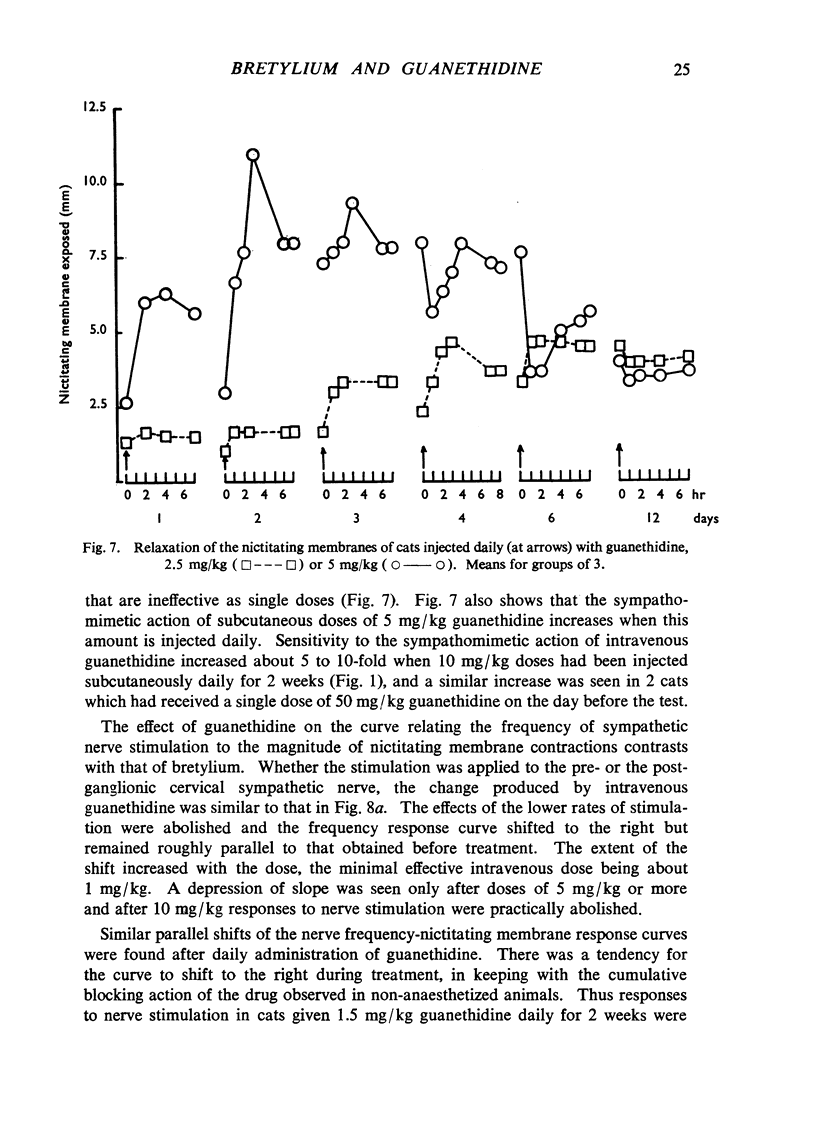
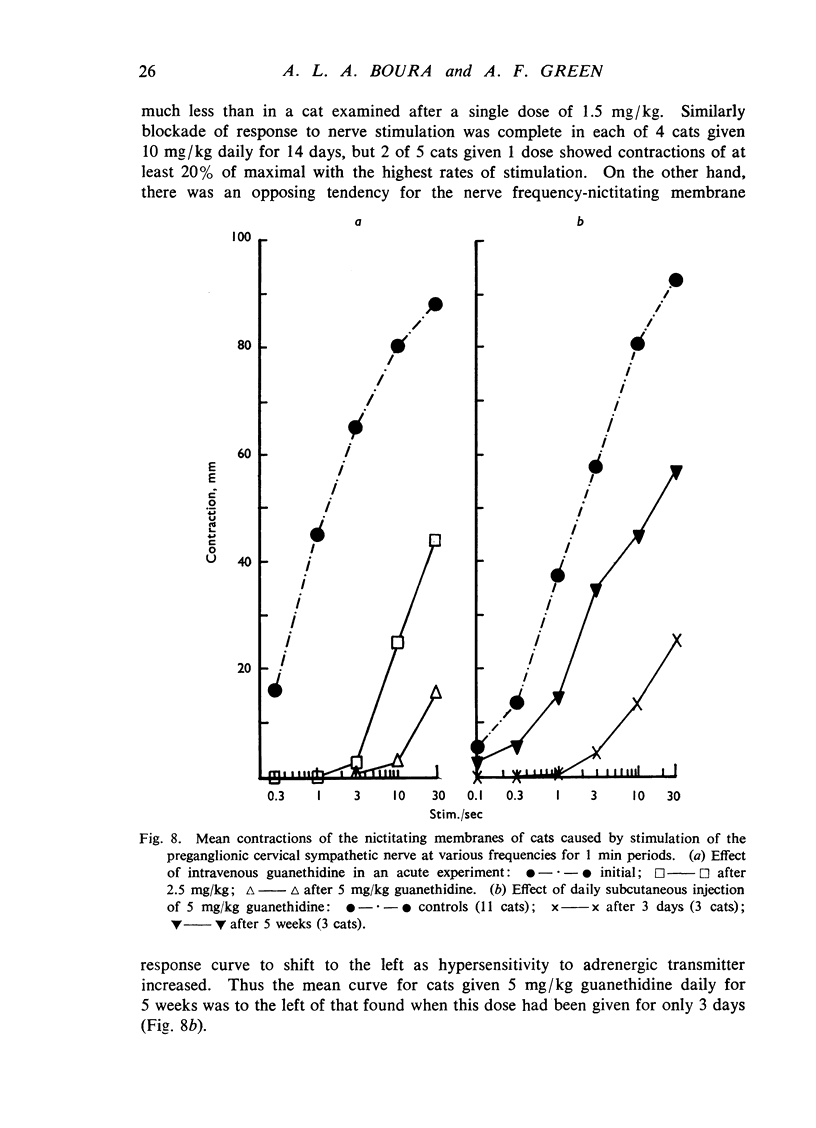
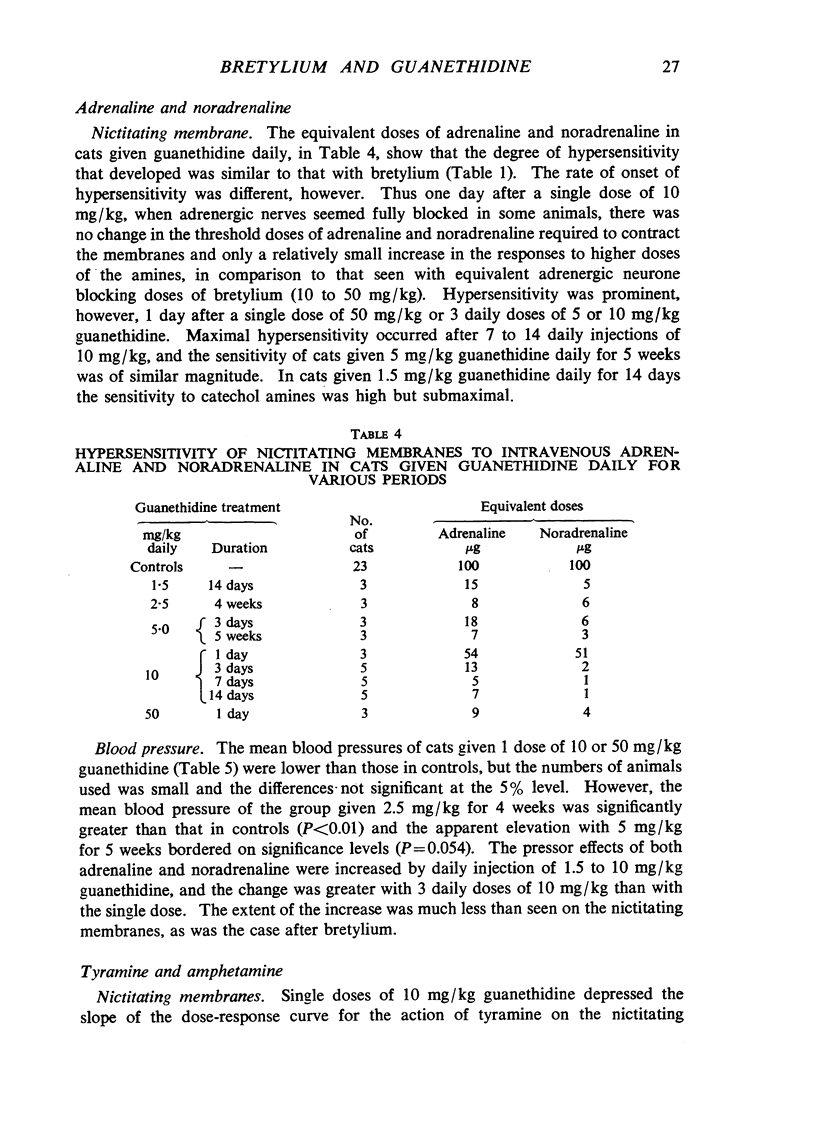
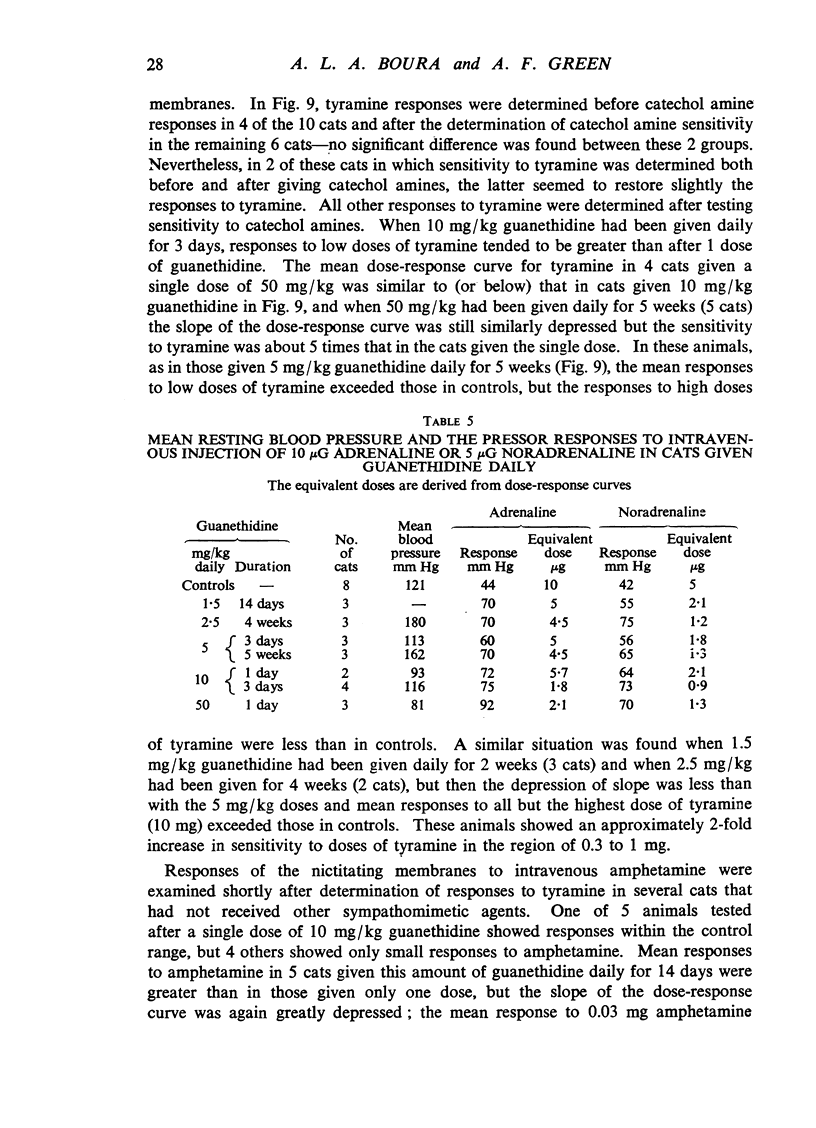

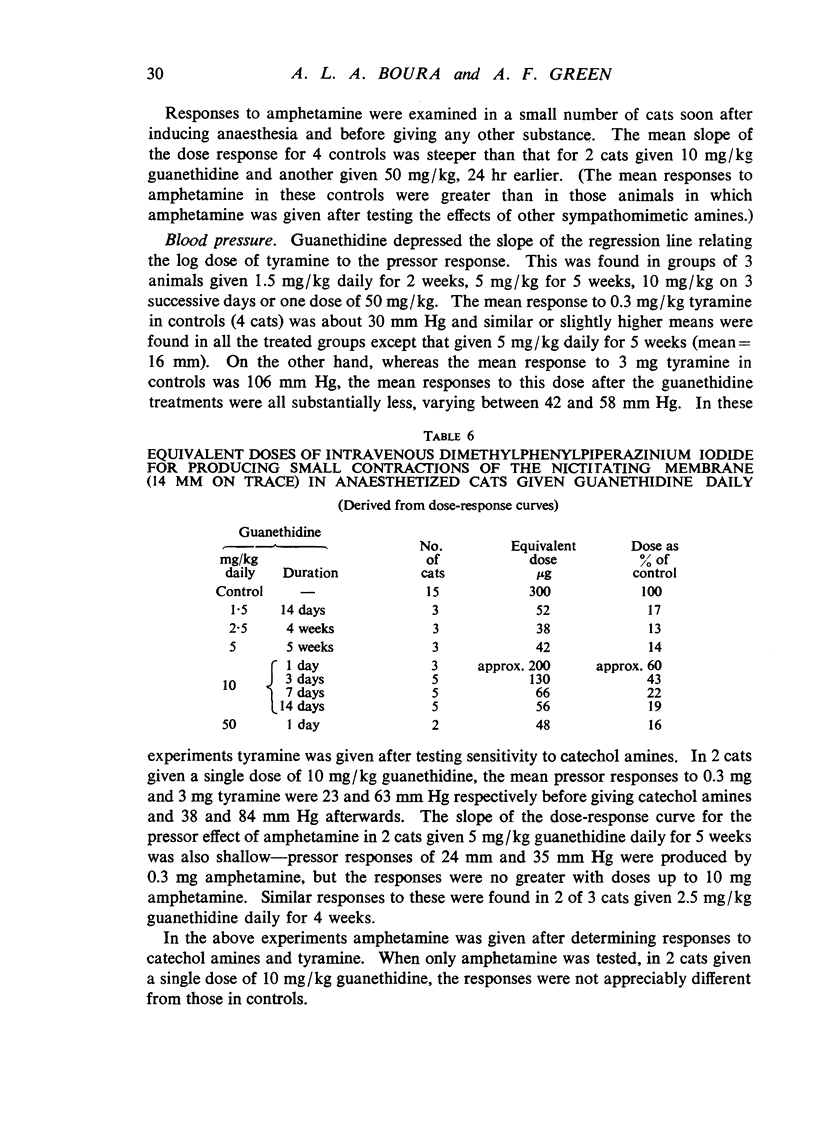
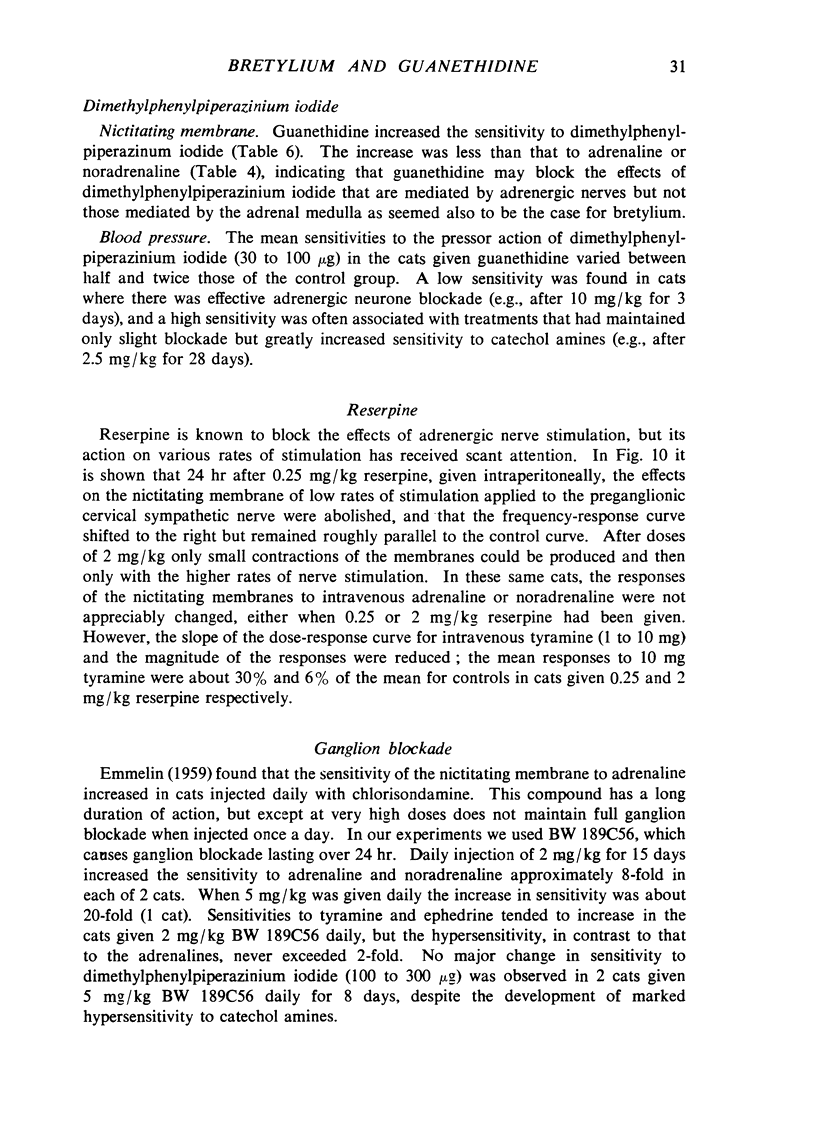
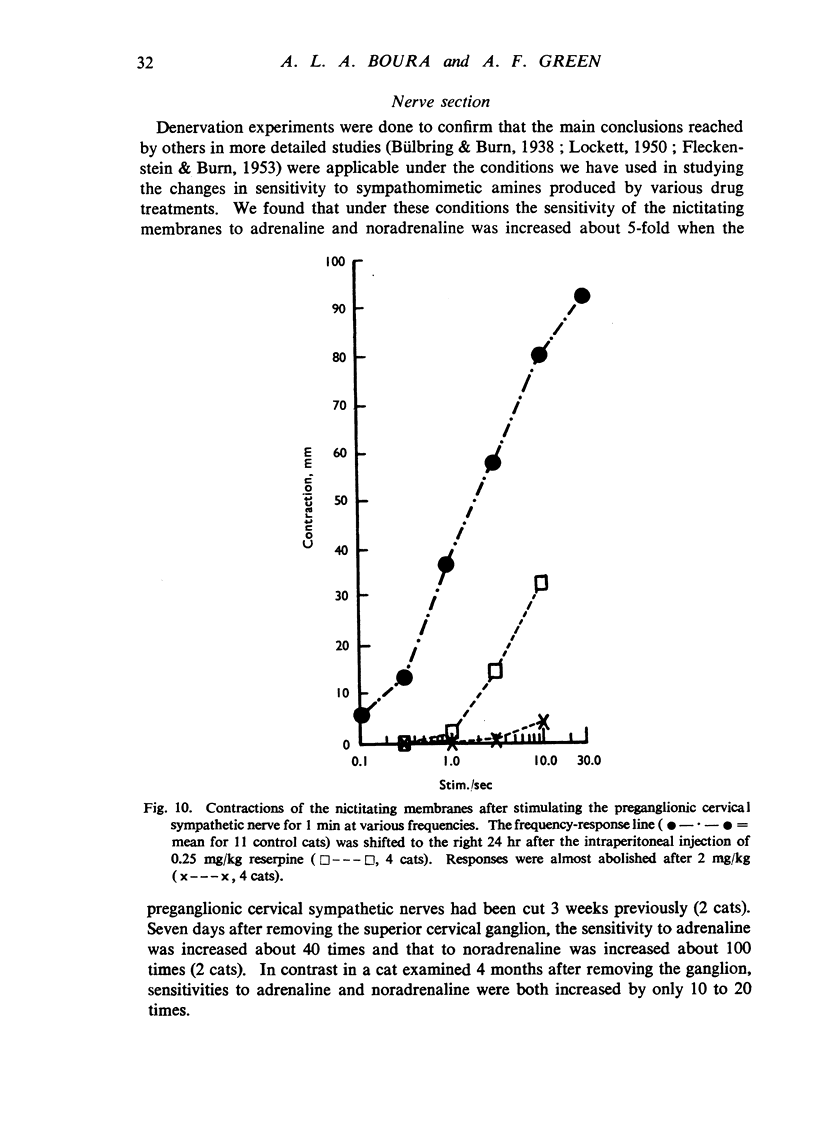
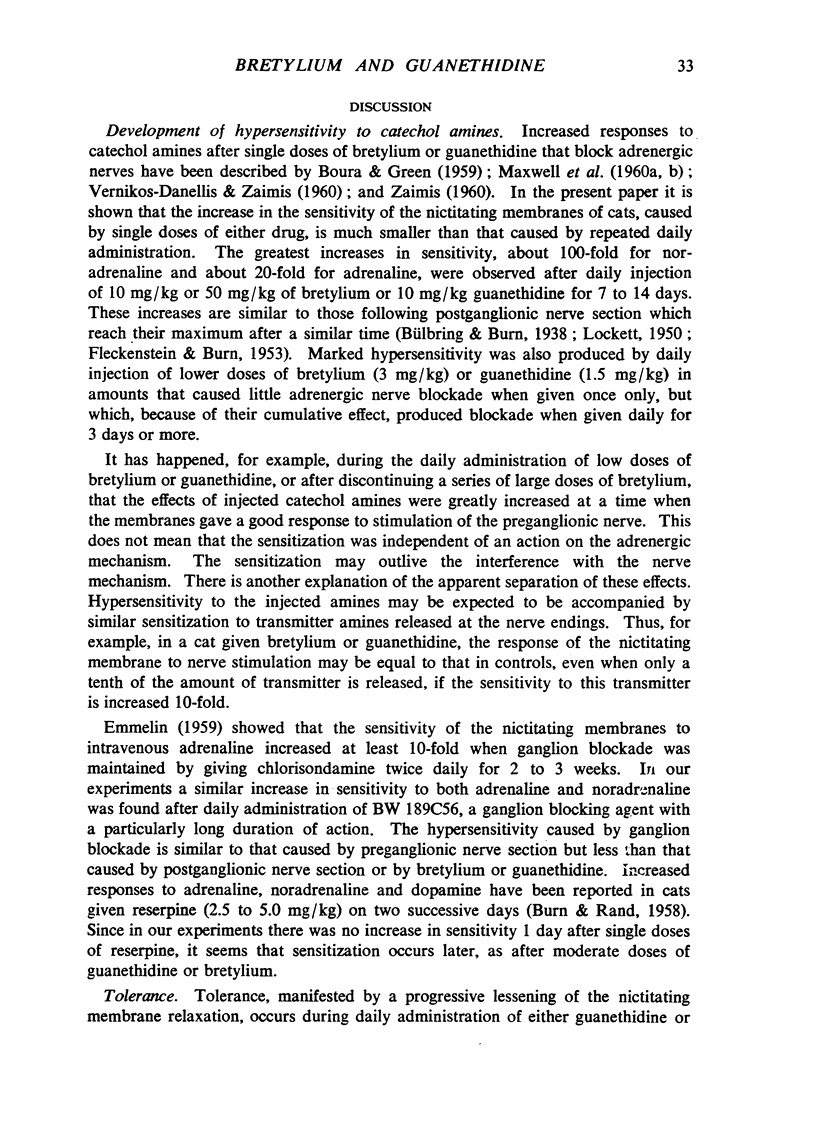
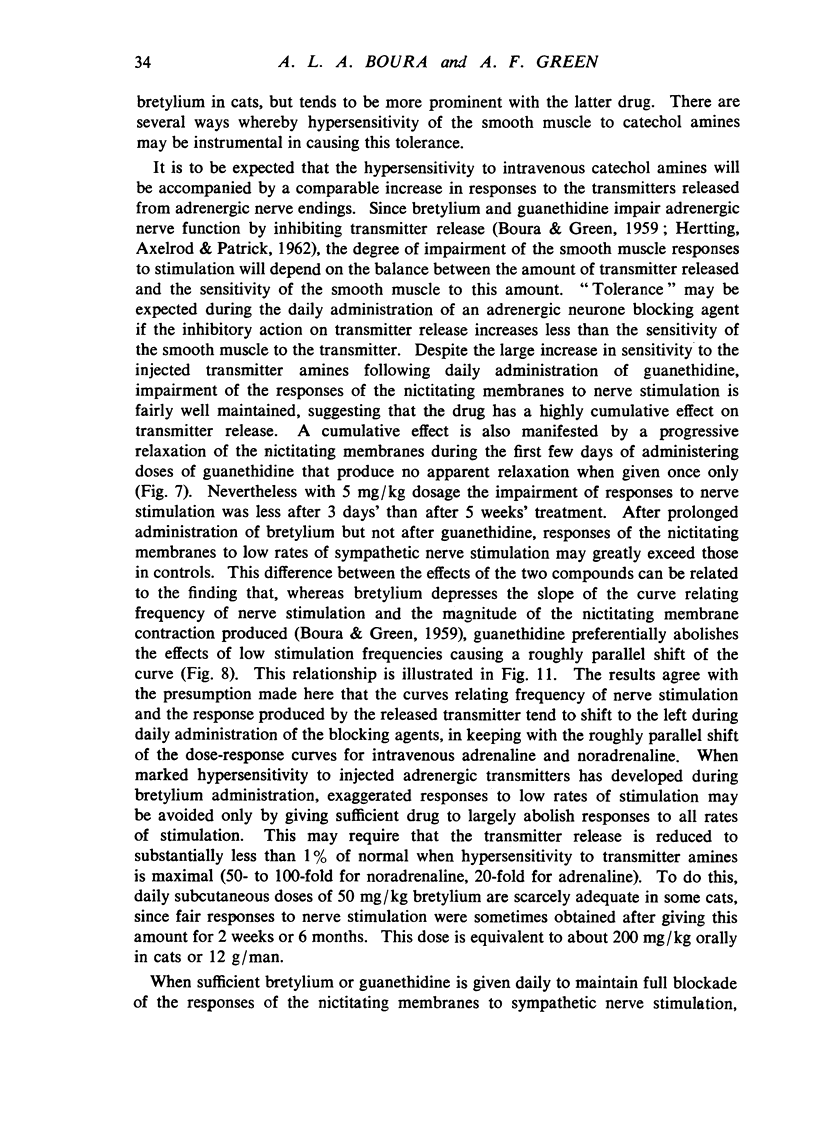
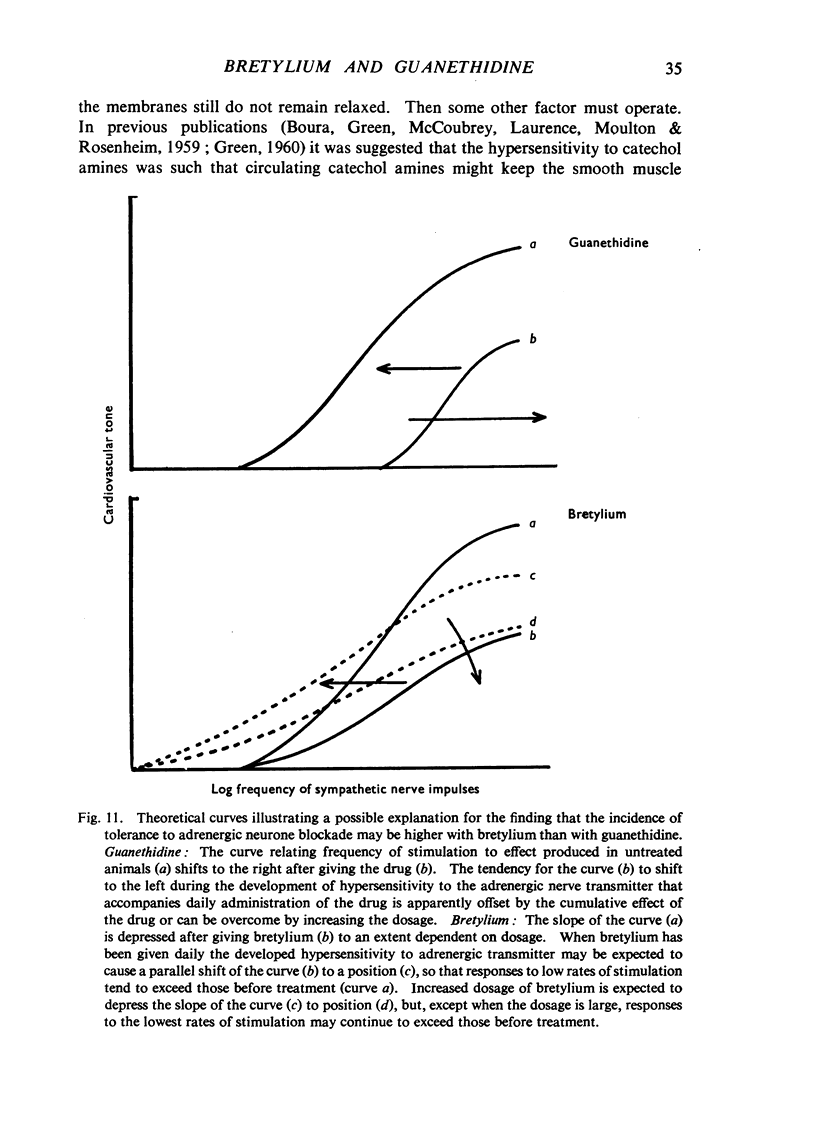
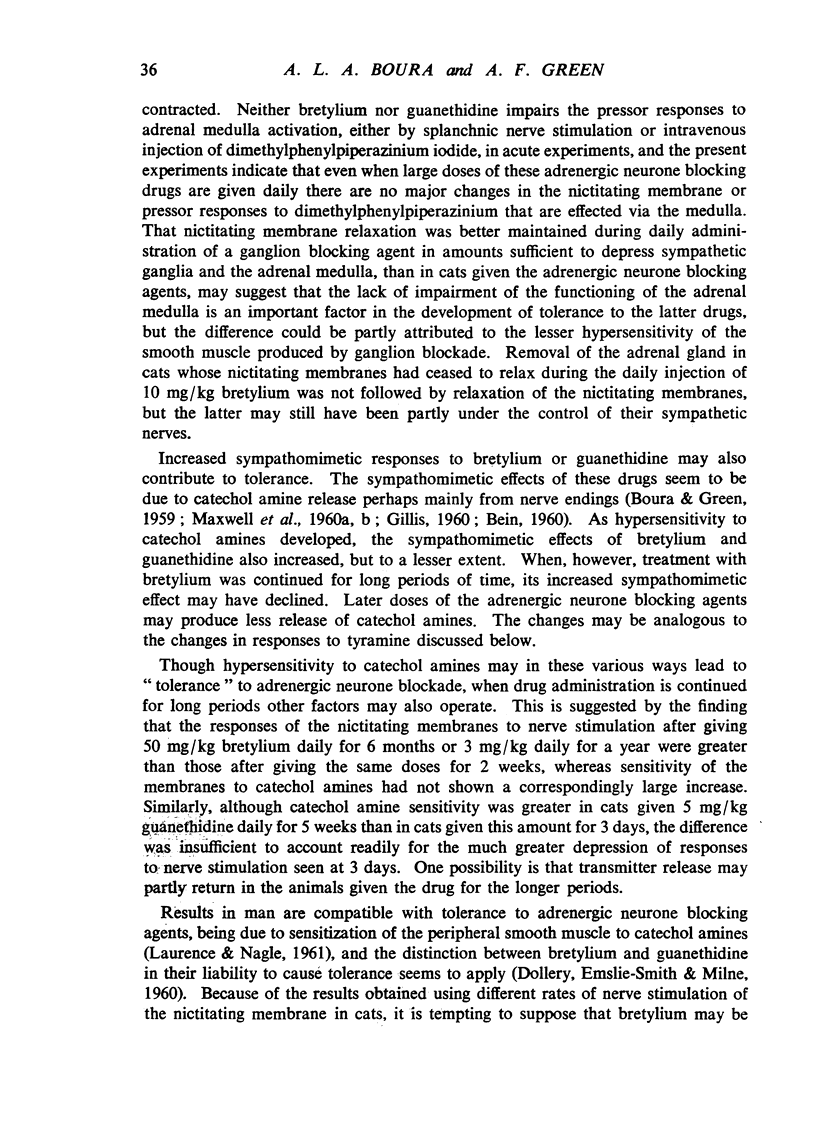
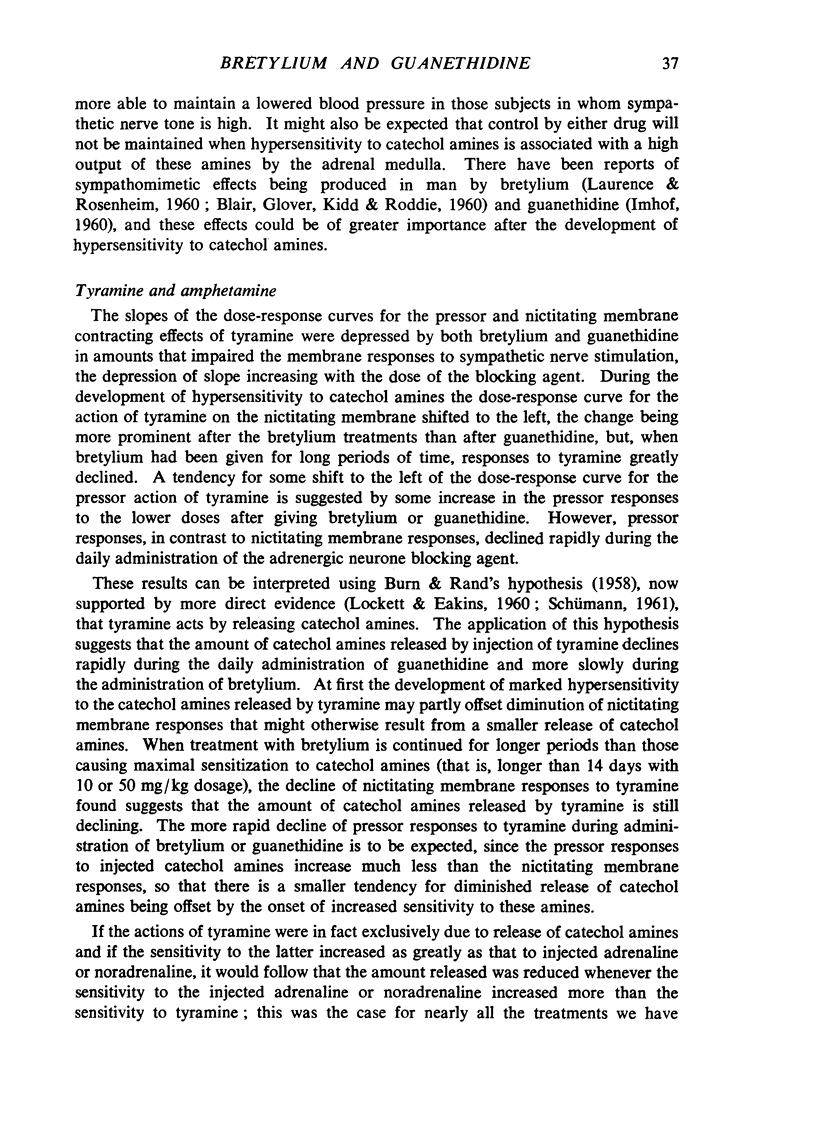
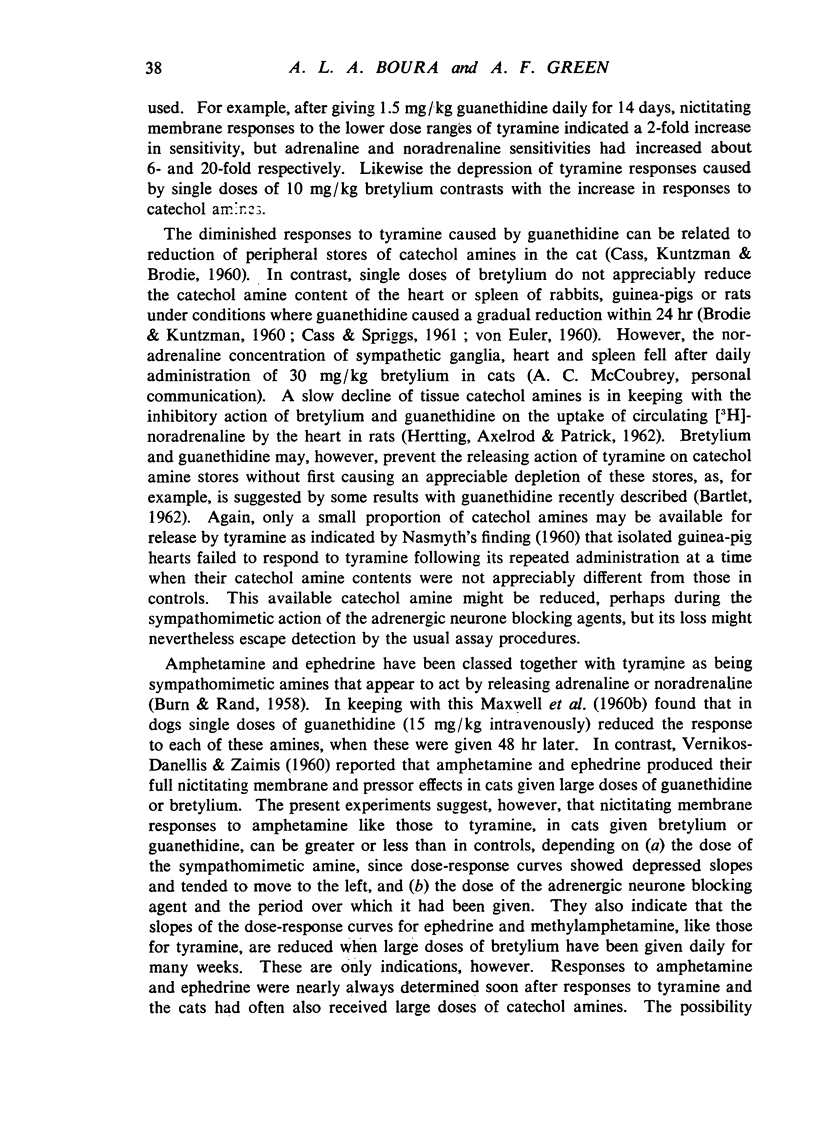
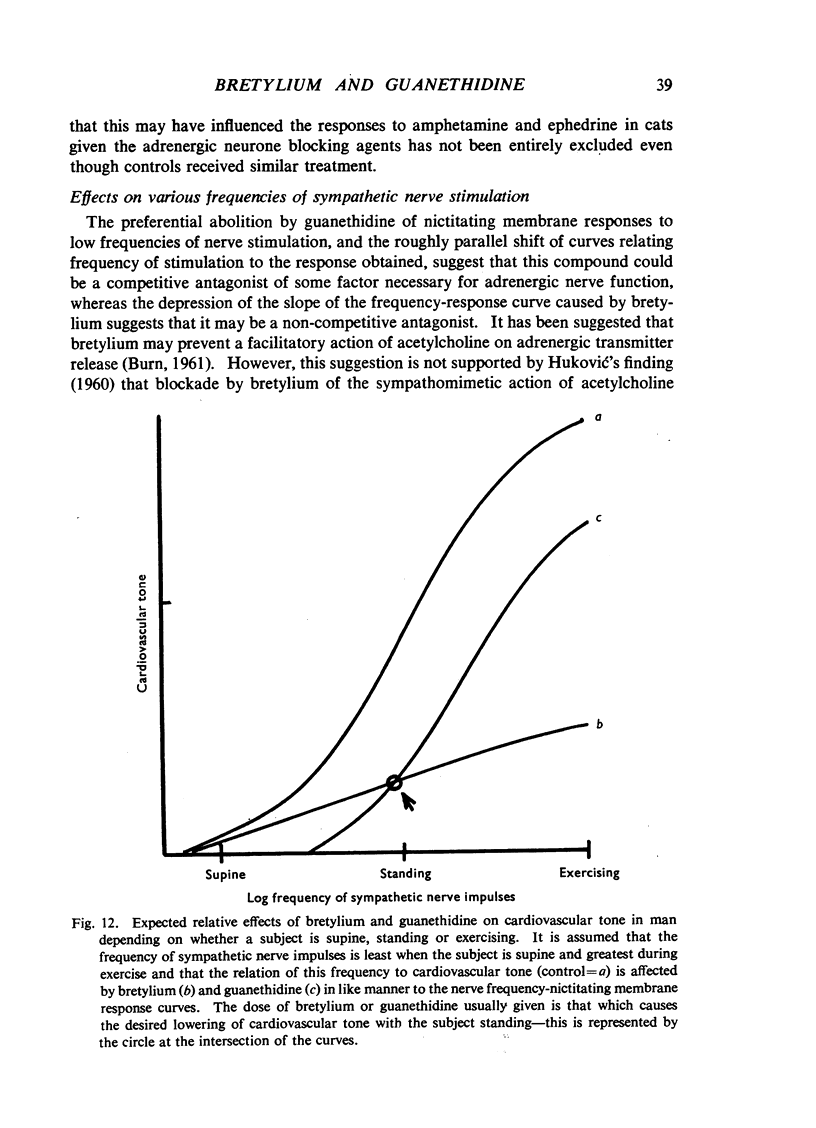
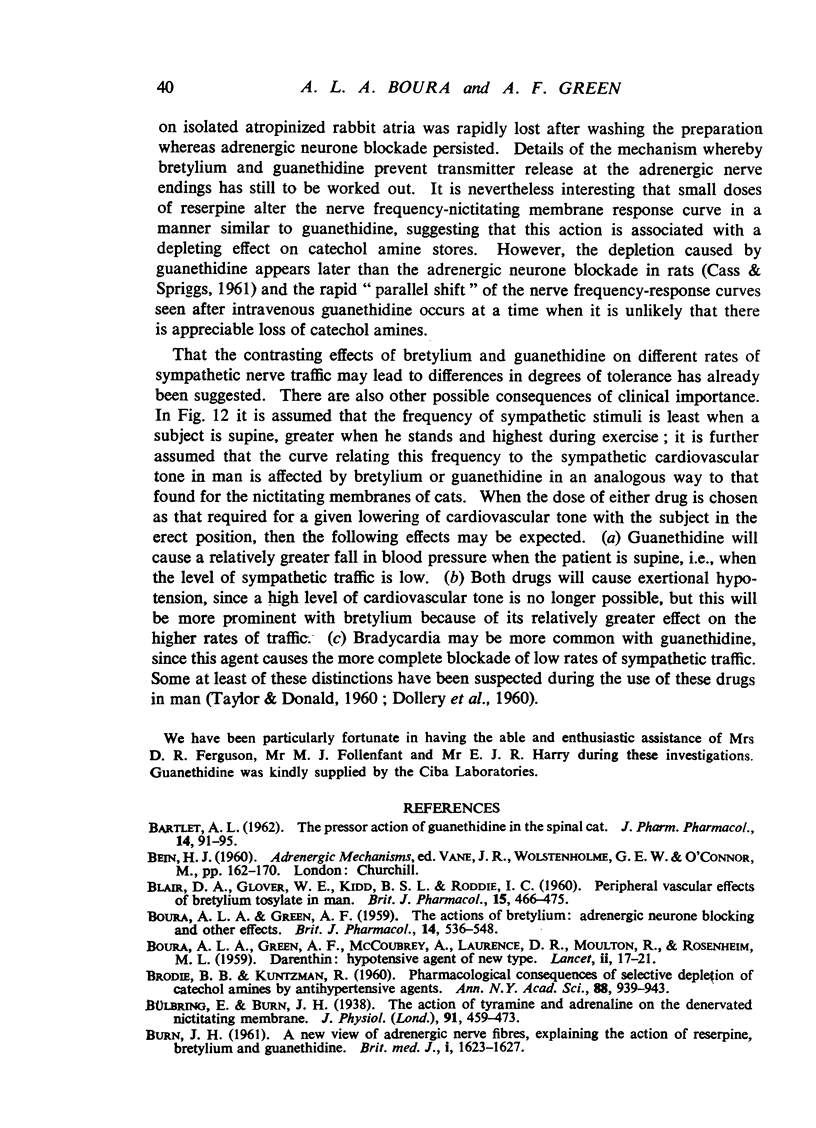
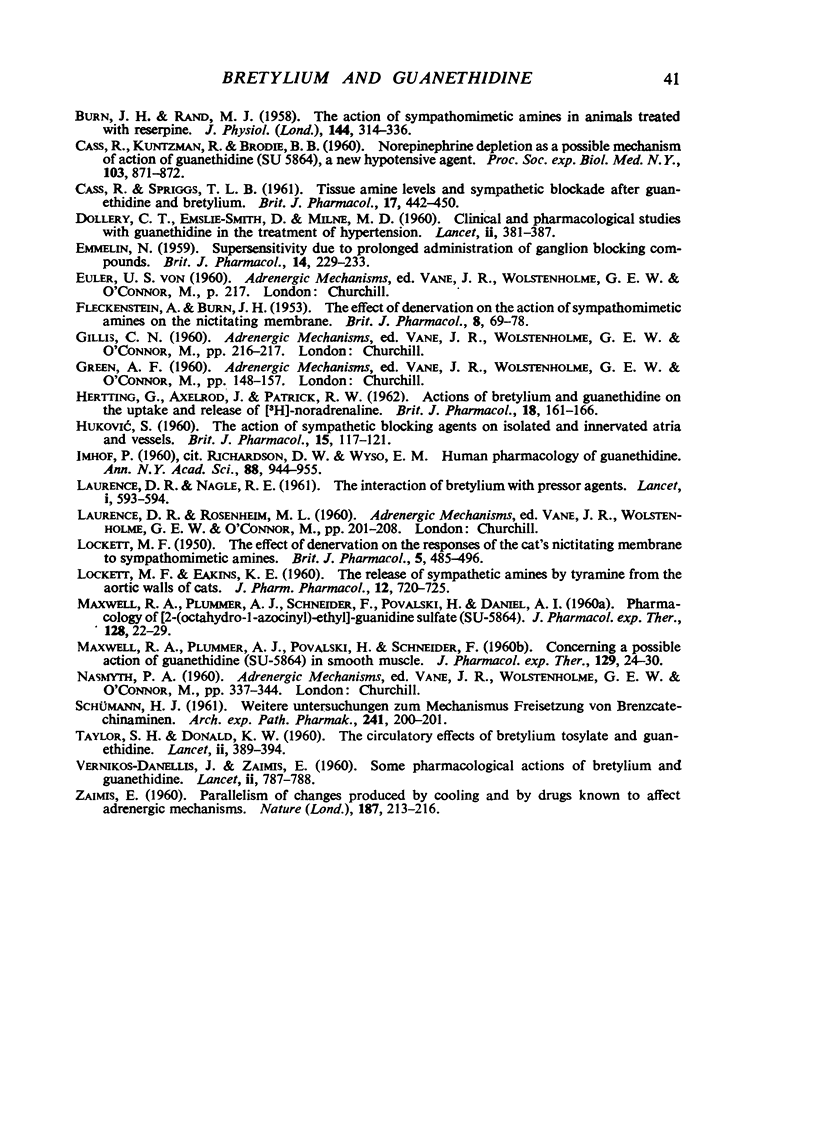
Selected References
These references are in PubMed. This may not be the complete list of references from this article.
- BARTLET A. L. The pressor action of guanethidine in the spinal cat. J Pharm Pharmacol. 1962 Feb;14:91–95. doi: 10.1111/j.2042-7158.1962.tb11058.x. [DOI] [PubMed] [Google Scholar]
- BOURA A. L., GREEN A. F., McCOUBREY A., LAURENCE D. R., MOULTON R., ROSENHEIM M. L. Darenthin: hypotensive agent of new type. Lancet. 1959 Jul 11;2(7089):17–21. [PubMed] [Google Scholar]
- BOURA A. L., GREEN A. F. The actions of bretylium: adrenergic neurone blocking and other effects. Br J Pharmacol Chemother. 1959 Dec;14:536–548. doi: 10.1111/j.1476-5381.1959.tb00961.x. [DOI] [PMC free article] [PubMed] [Google Scholar]
- BURN J. H. A new view of adrenergic nerve fibres, explaining the action of reserpine, bretylium, and guanethidine. Br Med J. 1961 Jun 10;1(5240):1623–1627. doi: 10.1136/bmj.1.5240.1623. [DOI] [PMC free article] [PubMed] [Google Scholar]
- BURN J. H., RAND M. J. The action of sympathomimetic amines in animals treated with reserpine. J Physiol. 1958 Dec 4;144(2):314–336. doi: 10.1113/jphysiol.1958.sp006104. [DOI] [PMC free article] [PubMed] [Google Scholar]
- Bülbring E., Burn J. H. The action of tyramine and adrenaline on the denervated nictitating membrane. J Physiol. 1938 Jan 14;91(4):459–473. doi: 10.1113/jphysiol.1938.sp003573. [DOI] [PMC free article] [PubMed] [Google Scholar]
- CASS R., KUNTZMAN R., BRODIE B. B. Norepinephrine depletion as a possible mechanism of action of guanethidine (SU 5864), a new hypotensive agent. Proc Soc Exp Biol Med. 1960 Apr;103:871–872. doi: 10.3181/00379727-103-25702. [DOI] [PubMed] [Google Scholar]
- DOLLERY C. T., EMSLIE-SMITH D., MILNE M. D. Clinical and pharmacological studies with guanethidine in the treatment of hypertension. Lancet. 1960 Aug 20;2(7147):381–387. doi: 10.1016/s0140-6736(60)92836-1. [DOI] [PubMed] [Google Scholar]
- EMMELIN N. Supersensitivity due to prolonged administration of ganglion-blocking compounds. Br J Pharmacol Chemother. 1959 Jun;14(2):229–233. doi: 10.1111/j.1476-5381.1959.tb01389.x. [DOI] [PMC free article] [PubMed] [Google Scholar]
- FLECKENSTEIN A., BURN J. H. The effect of denervation on the action of sympathomimetic amines on the nictitating membrane. Br J Pharmacol Chemother. 1953 Mar;8(1):69–78. doi: 10.1111/j.1476-5381.1953.tb00754.x. [DOI] [PMC free article] [PubMed] [Google Scholar]
- HERTTING G., AXELROD J., PATRICK R. W. Actions of bretylium and guanethidine on the uptake and release of [3H]-noradrenaline. Br J Pharmacol Chemother. 1962 Feb;18:161–166. doi: 10.1111/j.1476-5381.1962.tb01159.x. [DOI] [PMC free article] [PubMed] [Google Scholar]
- HUKOVIC S. The action of sympathetic blocking agents on isolated and innervated atria and vessels. Br J Pharmacol Chemother. 1960 Mar;15:117–121. doi: 10.1111/j.1476-5381.1960.tb01218.x. [DOI] [PMC free article] [PubMed] [Google Scholar]
- LAURENCE D. R., NAGLE R. E. The interaction of bretylium with pressor agents. Lancet. 1961 Mar 18;1(7177):593–594. doi: 10.1016/s0140-6736(61)92254-1. [DOI] [PubMed] [Google Scholar]
- LOCKETT M. F., EAKINS K. E. The release of sympathetic amines by tyramine from the aortic walls of cats. J Pharm Pharmacol. 1960 Dec;12:720–725. doi: 10.1111/j.2042-7158.1960.tb12737.x. [DOI] [PubMed] [Google Scholar]
- MAXWELL R. A., PLUMMER A. J., SCHNEIDER F., POVALSKI H., DANIEL A. I. Pharmacology of [2-(octahydro-1-azocinyl)-ethyl]-guanidine sulfate (Su-5864). J Pharmacol Exp Ther. 1960 Jan;128:22–29. [PubMed] [Google Scholar]
- RICHARDSON D. W., WYSO E. M. Human pharmacology of guanethidine. Ann N Y Acad Sci. 1960 Oct 11;88:944–955. doi: 10.1111/j.1749-6632.1960.tb20086.x. [DOI] [PubMed] [Google Scholar]
- TAYLOR S. H., DONALD K. W. The circul atory effects of bretylium tosylate and guanethidine. Lancet. 1960 Aug 20;2(7147):389–394. doi: 10.1016/s0140-6736(60)92838-5. [DOI] [PubMed] [Google Scholar]
- VERNIKOS-DANELLIS J., ZAIMIS E. Some pharmacological actions of bretylium and guanethidine. Lancet. 1960 Oct 8;2(7154):787–788. doi: 10.1016/s0140-6736(60)91856-0. [DOI] [PubMed] [Google Scholar]
- ZAIMIS E. Parallelism of changes produced by cooling and by drugs known to affect adrenergic mechanisms. Nature. 1960 Jul 16;187:213–216. doi: 10.1038/187213a0. [DOI] [PubMed] [Google Scholar]


